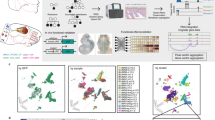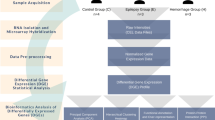Abstract
Martin–Bell syndrome is mainly caused by the expansion of CGG trinucleotide repeats (>200 CGG) in the first exon of the FMR1 gene, leading to hypermethylation of the promoter region and silencing of the FMR1 protein expression. These changes are responsible for a phenotype with varying degrees of mental retardation, a long face with large and protruding ears, macroorchidism and autistic behavior. There may also be, however, patients who exhibit typical features of the syndrome without any expansion in the FMR1 gene; thus, other mechanisms affecting the expression of the FMR1 gene were assessed in 25 out of 29 ascertained patients with the typical phenotype without full mutation. Promoter methylation status of FMR1, mutations in its sequence and copy number variations (CNVs) in genes associated with intellectual disability were investigated. In 25 independent male patients without expansion, the promoter region was unmethylated; one patient with a full mutation showed methylation mosaicism; and a female patient had 81.2% of CpG sites methylated and 18.8% hemimethylated. One heterozygous duplication in exon 6 of the PDCD6 gene (programmed cell death 6) and a heterozygous deletion in exon 5 of the CHL1 gene (cell adhesion molecule L1), respectively, were found in two independent patients.
Similar content being viewed by others
Log in or create a free account to read this content
Gain free access to this article, as well as selected content from this journal and more on nature.com
or
References
Martin, J. P. & Bell, J. A pedigree of mental defect showing sex-linkage. J. Neurol. Psychol. 6, 154–157 (1943).
Saul, R. A. & Tarleton, J. C . FMR1-Related disorders. in GeneReviews (Internet) (eds Pagon, R. A., Adam, M. P. & Ardinger, H. H.) (University of Washington, Seattle, WA, USA, 1993–2016). Available at: http://www.ncbi.nlm.nih.gov/books/NBK1384/ (Accessed on May 2015).
Turner, G., Webb, T., Wake, S. & Robinson, H. Prevalence of fragile X syndrome. Am. J. Med. Genet. 64, 196–197 (1996).
Verkerk, A. J., Pieretti, M., Sutcliffe, J. S., Fu, Y. H., Kuhl, D. P., Pizzuti, A. et al. Identification of a gene (FMR-1 containing a CGG repeat coincident with a breakpoint cluster region exhibiting length variation in fragile X syndrome. Cell 65, 905–914 (1991).
Coffee, B., Keith, K., Albizua, I., Malone, T., Mowrey, J., Sherman, S. L. et al. Incidence of fragile X syndrome by newborn screening for methylated FMR1 DNA. Am. J. Hum. Genet. 85, 503–514 (2009).
De Boulle, K., Verkerk, A., Reyniers, E., Vits, L., Hendrickx, J., Van Roy, B. et al. A point mutation in the FMR-1 gene associated with fragile X mental retardation. Nat. Genet 3, 31–35 (1993).
Lugenbeel, K. A., Peier, A. M., Carson, N. L., Chudley, A. E. & Nelson, D. L. Intragenic loss of function mutations demonstrate the primary role of FMR1 in fragile X syndrome. Nat. Genet. 10, 483–485 (1995).
Collins, S. C., Bray, S. M., Suhl, J. A., Cutler, D. J., Coffee, B., Zwick, M. E. et al. Identification of novel FMR1 variants by massively parallel sequencing in developmentally delayed male. Am. J. Med. Genet. A 152A, 2512–2520 (2010).
Grønskov, K., Brondum-Nielsen, K., Dedic, A. & Hjalgrim, H. A nonsense mutation in FMR1 causing fragile X syndrome. Eur. J. Hum. Genet. 19, 489–491 (2011).
Myrick, L., Nakamoto, M., Lindor, N., Kirmani, S., Cheng, X. & Warren, S. T. Fragile X syndrome due to a missense mutation. Eur. J. Hum. Genet. 22, 1–5 (2014).
Naumann, A., Hochstein, N., Weber, S., Fanning, E. & Doerfler, W. A distinct DNA-methylation boundary in the 5’- upstream sequence of the FMR1 promoter binds nuclear proteins and is lost in fragile X syndrome. Am. J. Med. Genet. 85, 606–616 (2009).
Garber, K. B., Visootsak, J. & Warren, S. T. Fragile X syndrome. Eur. J. Hum. Genet. 16, 666–672 (2008).
Sherman, S. Epidemiology. in Fragile X Syndrome: Diagnosis, Treatment, and Research (eds Hagerman, R. S. & Hagerman, P. J.) Ch. 3, 136–168, 3 edn (Johns Hopkins University Press, Baltimore, MD, USA, 2002).
Butler, M., Mangrum, T., Gupta, R. & Singh, D. A 15 item check-list for screening mentally retarded males for the fragile X syndrome. Clin. Genet. 39, 347–354 (1991).
Lahiri, D. & Nurnberger, J. A rapid non-enzymatic method for the preparation of HMW DNA from blood for RFLP studies. Nucleic Acids Res. 19, 5444 (1991).
Smith, K.T., Coffee, B. & Reines, D. Occupancy and synergistic activation of the FMR1 promoter by Nrf-1 and Sp1 in vivo. Hum. Mol. Genet 13, 1611–1621 (2004).
Kumari, D. & Usdin, K. Interaction of the transcription factors USF1,USF2, and a alpha-Pal/Nrf-1 with the FMR1 promoter. Implications for fragile X mental retardation syndrome. J. Biol. Chem. 276, 4357–4364 (2001).
Stöger, R., Kajimura, T., Brown, W. & Laird, C. Epigenetic variation illustrated by DNA methylation patterns of the fragile-X gene FMR1. Hum. Mol. Genet. 6, 1791–1801 (1997).
Dahl, C., Grønskov, K., Larsen, L., Guldberg, P. & Brondum- Nielsen, K. A homogeneous assay for analysis of FMR1 promoter methylation in patients with fragile X syndrome. Clin. Chem. 53, 790–793 (2007).
Koolen, D., Nillesen, W., Versteeg, M., Merkx, G., Knoers, M., Kets, M. et al. Screening for subtelomeric rearrangements in 210 patients with unexplained mental retardation using multiplex ligation dependent probe amplification (MLPA). J. Med. Genet. 41, 892–899 (2004).
Gecz, J. The FMR2 gene, FRAXE and non-specific X-linked mental retardation: clinical and molecular aspects. Ann. Genet. 64, 95–106 (2000).
Angeloni, D., Lindor, N., Pack, S., Latif, F., Wei, M. H. & Lerman, M. CALL gene is haploinsufficient in a 3p-syndrome patient. Am. J. Med. Genet. 86, 482–485 (1999).
Frints, S., Marynen, P., Hartmann, D., Fryns, J. P., Steyaert, J., Schachner, M. et al. CALL interrupted in a patient with non-specific mental retardation: gene dosage-dependent alteration of murine brain development and behavior. Hum. Mol. Genet. 12, 1463–1474 (2003).
Pohjola, P., de Leeuw, N., Penttinen, M. & Kääriäinen, H. Terminal 3p deletions in two families—correlation between molecular karyotype and phenotype. Am. J. Med. Genet. A 152A, 441–446 (2010).
Wang, J. C., Coe, B., Lomax, B., MacLeod, P., Parslow, M., Schein, E. et al. Inverted duplication with terminal deletion of 5p and no cat-like cry. Am. J. Med. Genet. A 146A, 1173–1179 (2008).
Izzo, A., Genesio, R., Ronga, V., Nocera, V., Marullo, L., Cicatiello, R. et al. 40 Mb duplication in chromosome band 5p13.1p15.33 with 800 kb terminal deletion in a foetus with mild phenotypic features. Eur. J. Med. Genet. 55, 140–144 (2012).
Izzo, G., Freitas, E. L., Krepischi, A. C., Pearson, P. L., Vasques, L. R., Passos-Bueno, M. R. et al. A microduplication of 5p15.33 reveals CLPTM1L as a candidate gene for cleft lip and palate. Eur. J. Med. Genet. 56, 222–225 (2013).
Lubs, H. A. A marker X chromosome. Am. J. Hum. Genet. 21, 231–244 (1969).
Richards, B. W. & Webb, T. The Martin–Bell-Renpenning syndrome. J. Med. Genet. 19, 79 (1982).
Youings, S. A., Murray, A., Dennis, N., Ennis, S., Lewis, C., McKechnie, N. et al. FRAXA and FRAXE: the results of a five years survey. J. Med. Genet. 37, 415–421 (2000).
De Vries, B. B., Van den Ouweland, A. M., Mohkamsing, S., Duivenvoorden, H. J., Mol, E., Gelsema, K. et al. Screening and diagnosis for the fragile X syndrome among the mentally retarded: an epidemiological and psychological survey. Collaborative Fragile X Study Group. Am. J. Hum. Genet. 61, 660–667 (1997).
Millán, J. M., Martínez, F., Cadroy, A., Gandia, J., Casquero, M., Beneyto, M. et al. Screening for FMR1 mutation among the mentally retarded: prevalence of the fragile X syndrome in Spain. Clin. Genet. 56, 98–99 (1999).
Winarni, T., Utari, A., Mundhofir, F., Tong, T., Durbin-Johnson, B., Faradz, S. et al. Identification of expanded allele of the FMR1 gene among high-risk population in Indonesia by using blood spot screening. Gen. Test. Mol. Bioma. 16, 162–166 (2012).
Lardoeyt, R., Lantigua, A., Willemsem, R., Collazo, T., Esperón, A. & Maceira, L. Epidemiología y genética del síndrome de frágil X en ciudad de La Habana, Cuba. Acta Biol. Colomb 13, 64 (2009).
Handt, M., Epplen, A., Hoffjan, S., Mese, K., Epplen, J. T. & Dekomien, G. Point mutation frequency in the FMR1 gene as revealed by fragile X syndrome screening. Mol. Cell. Probes 28, 279–283 (2014).
Acknowledgements
We thank Mary Acosta for her assistance with the capillary electrophoresis standardization. We also thank Dr María del Carmen Taboada from the National Child Psychiatry Unit of Caracas and Dr Orlando Arcia from the Concepción Palacios Maternity Hospital of Caracas for refering us some of the patients.
Author information
Authors and Affiliations
Corresponding author
Ethics declarations
Competing interests
The authors declare no conflict of interest.
Rights and permissions
About this article
Cite this article
Vega, Y., Arias, S. & Paradisi, I. Most Martin–Bell syndrome (FMR1-related disorder) Venezuelan patients did not show CGG expansion but instead display genetic heterogeneity. J Hum Genet 62, 235–241 (2017). https://doi.org/10.1038/jhg.2016.114
Received:
Revised:
Accepted:
Published:
Issue date:
DOI: https://doi.org/10.1038/jhg.2016.114



